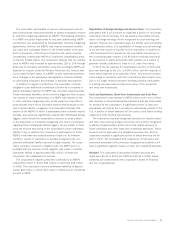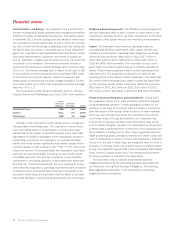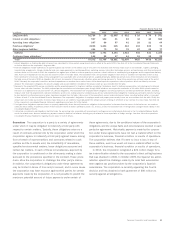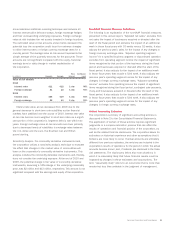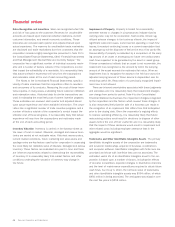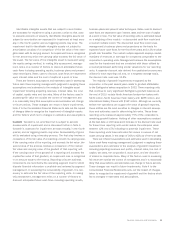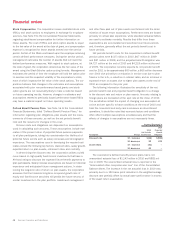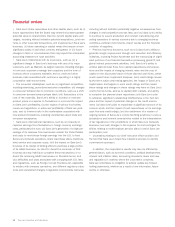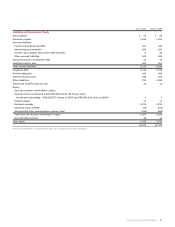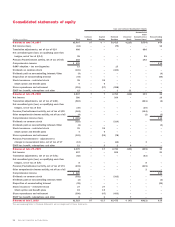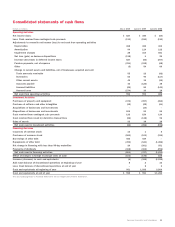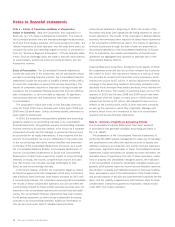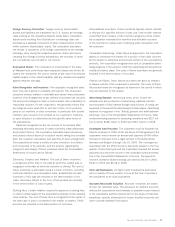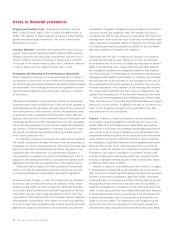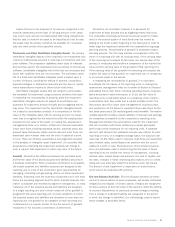Sara Lee 2010 Annual Report Download - page 51
Download and view the complete annual report
Please find page 51 of the 2010 Sara Lee annual report below. You can navigate through the pages in the report by either clicking on the pages listed below, or by using the keyword search tool below to find specific information within the annual report.As indicated above, changes in the bond yields, expected future
returns on assets, and other assumptions can have a material
impact upon the funded status and the net periodic benefit cost of
defined benefit pension plans. It is reasonably likely that changes
in these external factors will result in changes to the assumptions
used by the corporation to measure plan obligations and net periodic
benefit cost in future periods.
Issued but not yet Effective Accounting Standards
Following is a discussion of recently issued accounting standards
that the corporation will be required to adopt in a future period.
Consolidation of Variable Interest Entities
In June 2009, the FASB
issued an update to the guidance for determining whether an entity
is a variable interest entity (VIE) and who is the primary beneficiary
of the VIE. The new guidance will also require ongoing reassessments
of the primary beneficiary of a VIE and new expanded disclosures
surrounding the nature of the VIE and an entity’s involvement with
the VIE. The new guidance is effective for the corporation in the
first quarter of fiscal 2011. The corporation does not believe the
new guidance will have a material impact on the consolidated
financial statements.
Revenue Arrangements with Multiple Deliverables
In September
2009, new accounting guidance was issued concerning accounting
for revenue arrangements with multiple deliverables. The guidance
requires companies to allocate revenue in arrangements involving
multiple deliverables based on the estimated selling price of each
deliverable, even though such deliverables are not sold separately.
It also eliminates the requirement that all undelivered elements
must have objective and reliable evidence of fair value before a
company can recognize a portion of the overall arrangement fee
that is attributable to items that have already been delivered. The
guidance also establishes a selling price hierarchy for determining
the selling price of a deliverable and expands disclosures for multi-
ple-deliverable revenue arrangements. The new guidance is required
to be adopted by the corporation for revenue arrangements entered
into or materially modified at the beginning of 2011. The corpora-
tion is currently evaluating the provisions of this guidance and has
not determined the impact of adoption at this time.
Disclosures About the Credit Quality of Financing Receivables
and the Allowance for Credit Losses
On July 21, 2010 new
accounting guidance was issued that significantly expands the
disclosure requirements related to financing receivables and the
related allowance for credit losses. Specifically, the new guidance
requires, among other things, disclosure of: i) a rollforward of the
allowance for credit losses along with the balance of the allowance
reserve and the related financing receivable; ii) the reasons for the
changes in the allowance for credit losses; iii) the aging of past due
financing receivables at period end by customer class; iv) the nature
of credit risk inherent in the financing receivables; and v) how the
risk is analyzed and assessed in estimating the allowance for credit
losses. The new guidance is to be implemented in several steps with
the first implementation required in the second quarter of 2011.
Trade accounts receivable with contractual maturities of one year or
less that arose from the sales of goods or services are excluded
from the new guidance so the corporation believes this new guid-
ance will not result in significant new disclosures.
Forward-Looking Information
This document contains certain forward-looking statements, including
the anticipated costs and benefits of restructuring, transformation
and Project Accelerate actions, access to credit markets and the
corporation’s credit ratings, the planned extinguishment of debt,
the funding of pension plans, potential payments under guarantees
and amounts due under future contractual obligations and commit-
ments, projected capital expenditures, cash tax payments, pension
settlement amounts and effective tax rates. In addition, from time
to time, in oral statements and written reports, the corporation
discusses its expectations regarding the corporation’s future per-
formance by making forward-looking statements preceded by terms
such as “expects,” “projects,” “anticipates” or “believes.” These
forward-looking statements are based on currently available competi-
tive, financial and economic data, as well as management’s views
and assumptions regarding future events. Such forward-looking
statements are inherently uncertain, and investors must recognize
that actual results may differ from those expressed or implied in the
forward-looking statements. Consequently, the corporation wishes
to caution readers not to place undue reliance on any forward-looking
statements. Among the factors that could cause Sara Lee’s actual
results to differ from such forward-looking statements are factors
relating to:
Sara Lee Corporation and Subsidiaries 49


